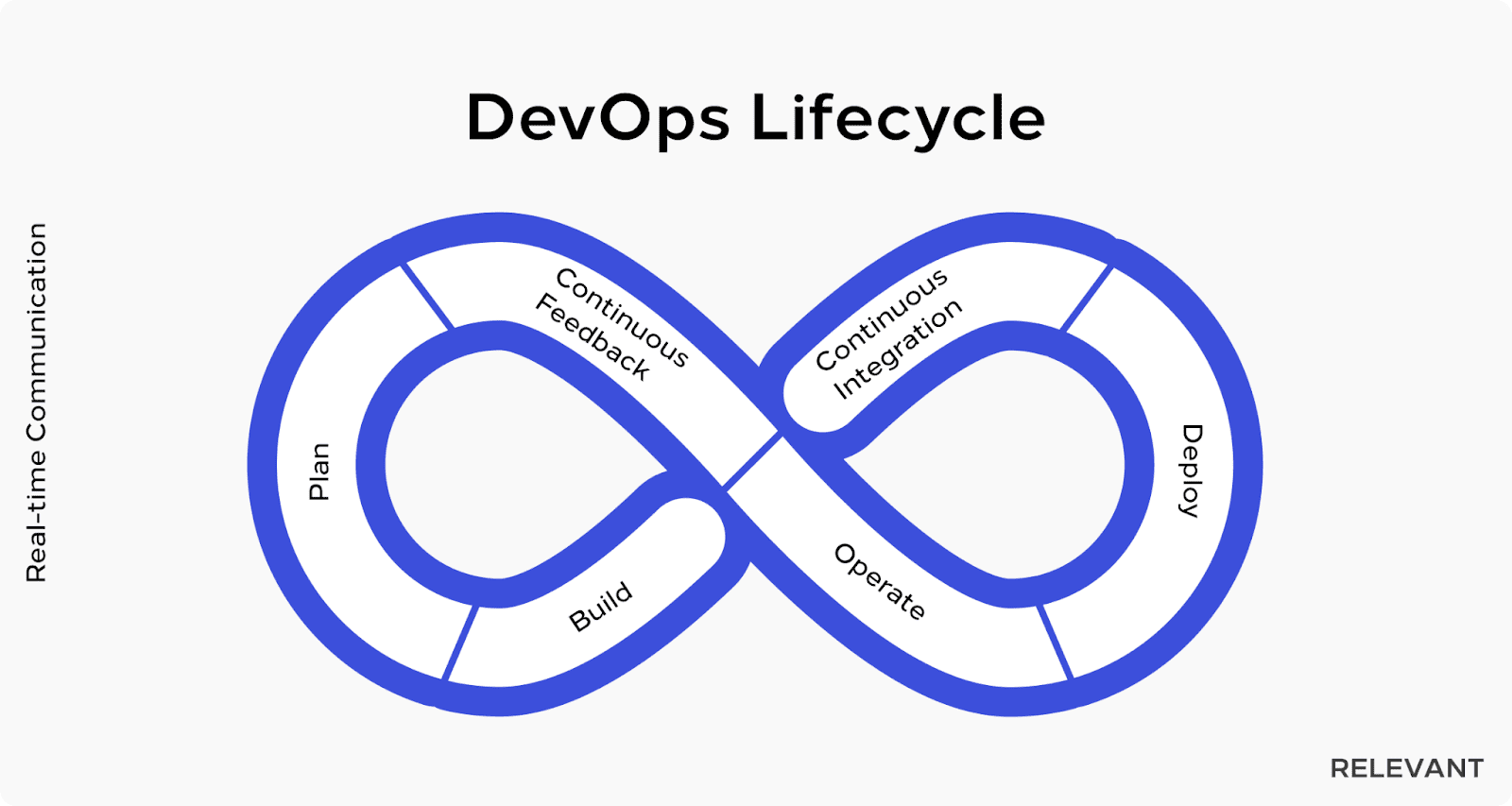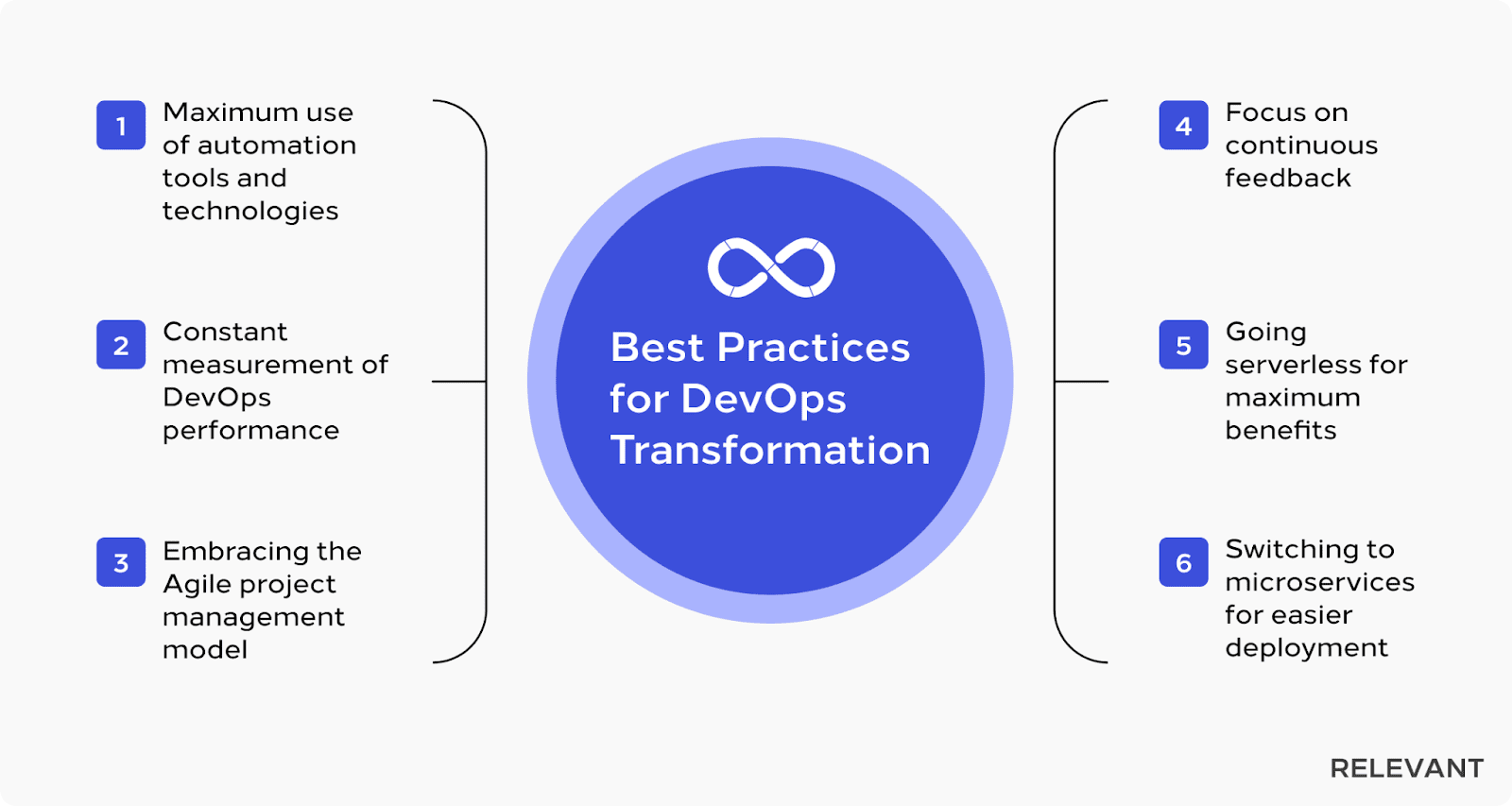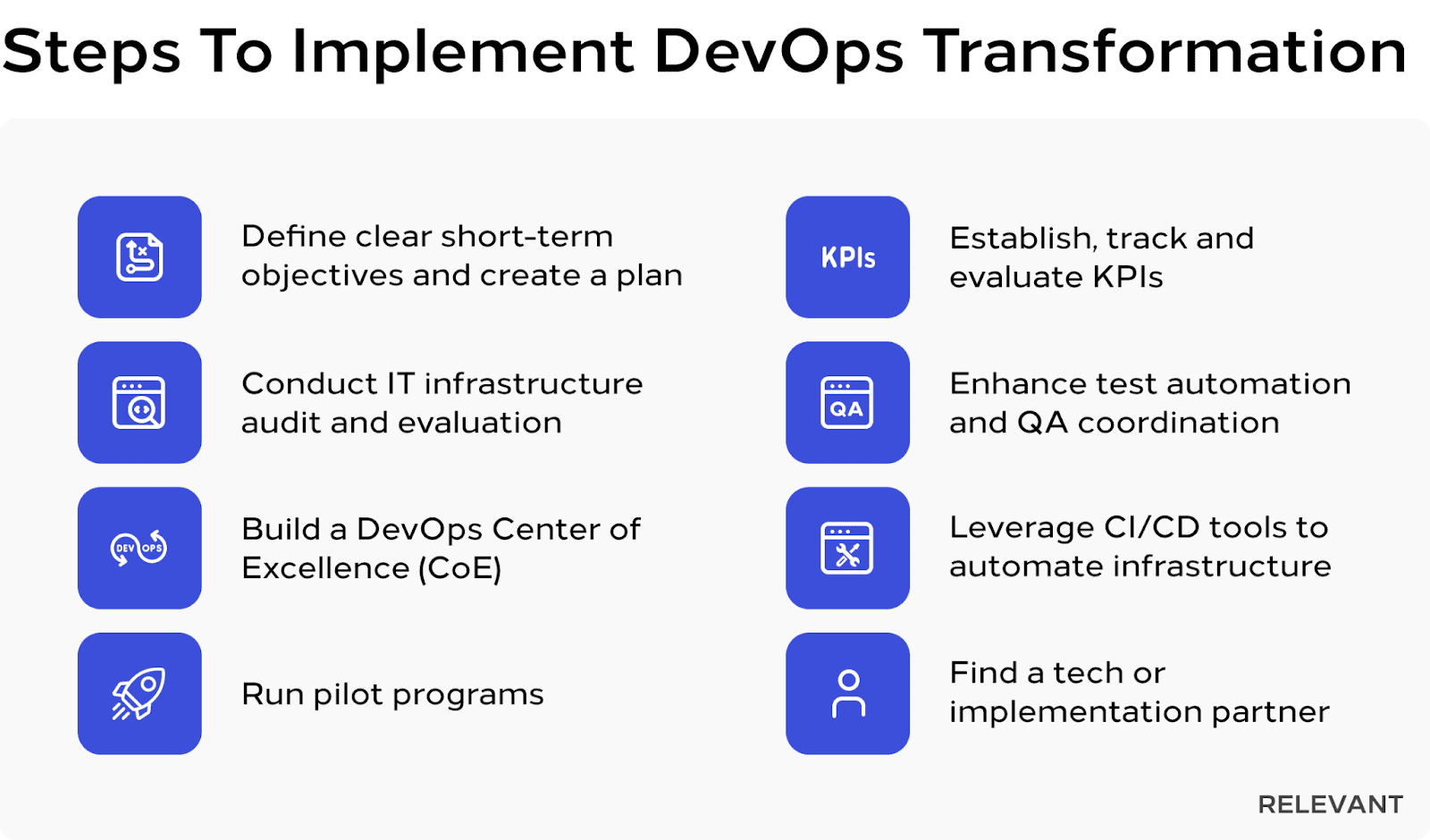DevOps Transformation in 2025: Approach, Benefits, and Best Practices
Updated: June 4, 2025
These days, many companies are looking to improve their delivery approach to raise the bar even higher. For faster releases and better development, having a DevOps mindset is essential. The DevOps transformation has changed the way IT operates by bringing teams together without wasting any time or effort to move ahead.
While 46% of organizations surveyed by Atlassian are still new to DevOps, getting started with DevOps transformation in 2025 will enable companies to optimize resources, accelerate software delivery, and address market needs efficiently. So let’s find out how to develop a DevOps transformation strategy and redefine the ways you build, test, deploy and maintain your software solutions.

We provide companies with senior tech talent and product development expertise to build world-class software. Let's talk about how we can help you.
Contact usTable of Contents
Understanding DevOps Transformation
Before we draw a DevOps transformation roadmap, let’s capture the essence of DevOps transformation as a process. DevOps transformation can be defined as switching to an Agile-inspired approach of bridging the gap between development and operations teams, ensuring their better collaboration, shortening the system development lifecycle, and ensuring continuous delivery of higher-quality software.

According to this definition, DevOps transformation requires leveraging DevOps automation tools and redefining both the software development toolsets and development culture at once. The latter, in turn, should be aligned with the main DevOps principles of collaboration, data-based and customer-centric decision-making, constant feedback and improvement, shared responsibility, and automation.

Source: Atlassian
Main Benefits of DevOps Transformation
99% of companies surveyed by Atlassian recognize that DevOps transformation has a positive impact on their organizations. Below are the main value-adding benefits they reported.
Higher quality deliverables
DevOps is a strategy that helps you to deliver higher quality deliverables faster. It heavily relies on data, helping to define and prioritize the most critical issues for the product owner and end users. Addressing them in the first place allows businesses to increase the quality of deliverables from cycle to cycle.
Faster time to market
DevOps shortens time to market through testing automation, which, in turn, boosts the team’s productivity, allows them to avoid time-consuming and routine tasks, and significantly reduces the probability of a mistake. With a well-thought-out DevOps transformation strategy in place, you can deliver faster by aligning the needs of your developers with those of your IT operations team. Plus, you can increase team productivity by providing visibility into how long tasks take to complete, so you can better align your resources with demand.
Improved deployment frequency
The DevOps transformation is also about increasing deployment frequency and supporting higher-level business requirements. Continuous deployment is one of the pillars of DevOps methodology that enables tech teams to adjust to the changing market demands faster, adding new features almost on the go. In addition, the quality of each new software piece remains high due to automated testing, improved collaboration, and continuous feedback.
Better team culture and improved collaboration
DevOps transformation is all about improving the culture of the organization and streamlining the collaboration between development and operations teams. It encourages ideas sharing and frequent communication. From this perspective, the goal of DevOps transformation is to create a more agile, collaborative team that can respond quickly to business demands.
Faster recovery time
Another core benefit of DevOps transformation is not just faster releases but also faster recovery times when problems occur. It also helps organizations maintain high levels of data security without compromising developer productivity or innovation. DevOps as a methodology also encourages treating failure as a learning opportunity and looking for ways to prevent failures for the same reasons in the future.
Building better products and services
The DevOps approach implies short product development cycles and frequent feedback from product owners, stakeholders, and customers. Starting the next cycle with first-hand feedback in mind allows for creating products and services fully aligned with business goals and customers’ expectations. This advantage of DevOps transformation makes DevOps for SaaS projects especially relevant since they should be equally focused on product quality and the service it delivers.
The lower failure rate of new releases and fewer incidents
Since DevOps methodology creates a more collaborative environment between development and testing teams, the probability of missing a critical bug becomes significantly lower. The principle of continuous testing also leaves no room for security loopholes. This benefit is especially critical for high-risk industries, making DevOps for fintech or governance even more essential.
Top 6 Best Practices for DevOps Transformation
The benefits of DevOps transformation are significant enough to start building a DevOps implementation roadmap right now. Below are practice-proven tips to follow along the way.

Maximum use of automation tools and technologies
Process automation is the main driving force behind DevOps. Although you can’t automate it all, there are critical processes that should be automated:
- Continuous integration/continuous delivery (CI/CD). Automating a CI/CD pipeline is a way to shorten the time to market, reduce the risk of issues and increase overall efficiency.
- Provisioning. Automated provisioning delivers instances on demand allocating only those computing resources that are needed.
- Application deployment. Automated application deployment accelerates software delivery from testing environments to production.
- Software testing. Running automated testing scenarios is an opportunity to find hard-to-detect errors with fewer resources spent.
- Log management. The goal of automated log management is to ease error identification and resolution.
- Automated app performance monitoring allows the developers to quickly address performance issues after a new feature is added.
Constant measurement of DevOps performance
DevOps is a data-driven practice, and this is one of the features that make it effective. The use of automation tools, including the ones for DevOps performance tracking, makes data gathering and analysis easier. There are four basic KPIs you have to track – deployment frequency, lead time for changes (code commit to code deploy), mean time to restore (MTTR), and the change failure rate.
Embracing the Agile project management model
The Agile project management model and DevOps methodology make a perfect match. Both of them stand for flexibility, collaboration between the team and the customer, transparent and frequent communication, and quick response to a change. Indeed, managing your project in an Agile manner requires thinking one step ahead, so if you are at the beginning of your development journey, consider hiring a dedicated team already experienced with working according to this methodology.
Focus on continuous feedback
Establishing clear communication practices between development and testing teams, product owners, stakeholders, and customers is another important practice for successful DevOps transformation. Fortunately, the Agile-driven project management style encourages efficient communication between them. It gives the product owner an opportunity to track the development process, get progress reports, meet their teams online, keep the team updated and share their concerns if any.
Going serverless for maximum benefits
Serverless architecture stands for such an execution model where the cloud service provider manages the allocation and provisioning of servers dynamically. With serverless computing, you only pay for the resources you use while your code is executed. You never have to worry about paying for idle capacity. This approach allows the developers to focus on the code instead of taking care of the environment, making operational management easier. Testing in serverless systems also becomes easier since the necessary resources are provided and scaled on demand.
Switching to microservices for easier deployment
Microservice architecture and DevOps also fit each other well. Microservices transform monolithic applications into decomposed ones, allowing cross-functional teams to develop, test and deploy the services independently from each other, improving fault isolation, agility and time to market.
How To Implement DevOps Transformation In 8 Steps
The right tools handled by high-skilled DevOps specialists, support from leadership, and clearly defined KPIs are the pillars of DevOps transformation. Here is how to implement it step-by-step.

Define clear short-term objectives and create a plan
Regardless of your DevOps transformation strategy, building a DevOps team is a goal that comes first. So, get started with outlining your team structure and size, proceed with defining the roles and responsibilities, and get started with hiring DevOps engineers and related specialists. Usually, a cross-functional DevOps team consists of a software developer/tester, automation engineer, quality assurance (QA) professional, security engineer, and release manager.
As an option, you can launch a recruitment campaign on your own and hire a DevOps team in-house but keep in mind that 28% of recruiters struggle to find DevOps candidates. Since their responsibilities go beyond the usual roles of a software developer or tester, finding candidates with the necessary skill set, background, and DevOps thinking can actually be a challenge. DevOps managed services are a wiser alternative, and we at Relevant would be glad to deliver them.
Conduct IT infrastructure audit and evaluation
The next step toward DevOps transformation is conducting an IT infrastructure audit. Its goal is to discover how IT systems function and define their weaknesses. When getting ready for DevOps transformation, the goal of an IT infrastructure audit is to find out whether the existing system has room for implementing DevOps and what points it lacks. In this case, the key tasks of an infrastructure audit are revising standards and procedures, checking the system’s performance and security, finding legacies, and reporting audit results.
Build a DevOps Center of Excellence (CoE)
DevOps Center of Excellence (CoE) is a framework that covers standards, procedures, and practices your cross-functional team will follow during the development, testing, deployment, and production process. Building a DevOps CoE covers gathering an expert team with cross-functional knowledge, establishing a knowledge and learning hub, defining the toolset, and paying special attention to automation solutions.
Establish, track and evaluate KPIs
There are a lot of DevOps practices you can track, for example, deployment frequency and time, change volume, deployment failure rate, change failure rate, time to detection, mean time to recovery, lead time, defect escape rate and volume, etc. At the beginning of your DevOps transformation journey, make sure to track the most critical KPIs – these are the ones directly related to your DevOps transformation goals.
Enhance test automation and QA coordination
After completing the IT infrastructure audit and setting the right KPIs, ensure you have a QA coordination process in place. For this reason, hiring a QA coordinator is a must-follow practice on the way to DevOps transformation. The main responsibility of this specialist is to ensure that the company’s QA processes and standards are met. In addition, a QA coordinator makes sure that the company’s products and services are compliant with industry-accepted quality standards.
Run pilot programs
A pilot program is a test run of a new process or system in order to evaluate its effectiveness and identify any potential issues before it’s implemented on a larger scale. Running pilot programs to test your DevOps strategy efficacy is one of the wisest approaches, largely inspired by the Lean development methodology.
A pilot program can help you determine if your organization is ready for a full DevOps transformation, so test your strategy step-by-step, getting started with your highest-priority goals and keeping a close eye on the essential KPIs we have mentioned earlier.
Find a tech or implementation partner
Although the core idea behind DevOps is easy to understand, DevOps transformation requires deep technical knowledge, skills, and the right tools. Partnering with a DevOps transformation services vendor makes accessing them easier and less costly. Supported by a tech company, you will be able to make your DevOps transformation path seamless and pitfalls-free, leveraging their practical experience and expertise.
Make the first step to DevOps transformation with Relevant
Starting your DevOps transformation now creates a future-proof opportunity to cut costs, speed up the development process, avoid costly mistakes and deliver software of higher quality, especially if you consider DevOps-as-a-service outsourcing.
Building a top-notch DevOps transformation team is the first step to achieving these goals at once, and Relevant Software would be glad to support you along the way. We have already helped more than 50+ companies with implementing smart DevOps strategies, sharing our practical experience and expertise, and using an advanced DevOps toolset.
Get in touch with our DevOps transformation company to hire a team with the necessary tech background and forward-thinking mindset.
FAQ
Our core services:
Do you want a price estimate for your project?
Do you know that we helped 200+ companies build web/mobile apps and scale dev teams?
Let's talk about your engineering needs.
Write to us











